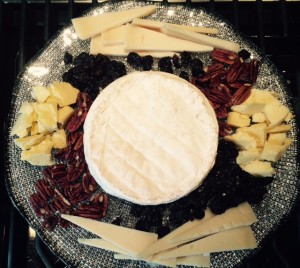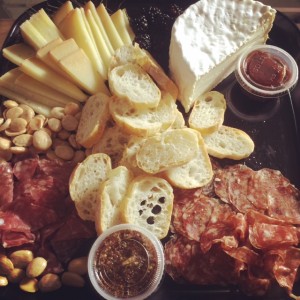Cheese is a wonderful way to begin or end a meal. Heck, it can even be a meal on its own! Many nights, I’ve grabbed bread, wine, and a hunk of my favorite cheddar or tomme and called it dinner. But creating a cheese board can be a bit overwhelming. How much should you use? How many varieties should you include? And with which accompaniments? I’m here to answer these questions and more. Let’s demystify the cheese board.
When buying for a cheese board, I get an ounce to an ounce and half of each cheese per person, depending on the cheese’s role in the meal. If it’s the star of the show, grab a little more. If it arrives at the end of the meal when everyone’s already stuffed, less is appropriate.
Now we can get down to business: choosing cheeses! Depending on how many people will partake in your fabulous board, I recommend selecting three to five cheeses. The rule of thumb here is variety. You should aim for a medley of milks (cow, goat, sheep, water buffalo, blends), a full spectrum of textures (fresh, soft, semi-soft, firm, hard), and an array of origins (French, Italian, Spanish, American, etc.). Unless you’re doing a themed plate, avoid a one-note cheese board and provide a wide range of offerings. Your local cheesemonger (me!) will be happy to help.

So, once you’ve got all of these delicious cheeses, what do you do with them? Plating is one the best parts of my job. I adore the art of building a gorgeous piece out of natural ingredients that guests will ooh and ahh over. Everyone has their own style, but I always abide by the Three Plating Commandments.
The First Commandment: Get your cheeses up to temperature. Cold cheeses will have a muted taste and a firmer, duller texture than room-temperature cheeses. To get the most out of your cheeses, take them out of the fridge at least an hour, if not two hours, before serving.
The Second Commandment: Make the the cheese easy to eat. Soft cheeses don’t need to be precut into slices, because they can be easily scooped up and spread with a knife. Harder cheeses should be sliced or crumbled. Don’t underestimate the beauty of a pile of large, rustic crumbles! Aesthetically, steer clear of grocery store-style cubes. Instead, try a cascade of thinly sliced wedges. Pro-tip: slice your cheeses while they’re still a bit chilled for a smoother cut.
The Third Commandment: Make your plate appear abundant. People are drawn to bounteous, plentiful arrangements. It’s also important to choose your plate or platter wisely, because going too big or too small can make plating difficult. Fill in the gaps between cheeses with accompaniments like slices of apple or pear, bunches of grapes, toasted walnuts, spiced pecans, and small bowls of jams or chutneys. Again, this is where your cheesemonger can be very helpful! Ask what would pair best with your specific cheeses. They might suggest fun combinations you hadn’t imagined! One of my off-the-wall favorites is very aged gouda (at least two years, but preferably four or five) with butterscotch sauce. The sweet nuttiness of the cheese combined with the salty-sweet sauce is just incredible.
I hope these tips help you navigate your next cheese board. Remember, when in doubt, talk to your cheesemonger. We’re here to make you feel comfortable with your selections, and to help you discover new and thrilling ways to explore the world of cheese!



